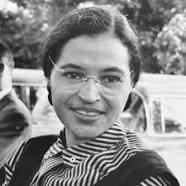Reflection two coming at you!
For my second reflection, I chose to do…essentially a podcast but I have a video of a slideshow with a bunch of pictures that fit to what I am saying. At first I had no clue what I wanted to do because I had already done a video project of me, and I don’t really like Explain Everything’s… I was thinking of just doing a podcast but I wanted to add the effect of pictures. So I combined the two!
First I researched a lot more about Rosa Parks and the Montgomery Bus Boycott, and I watched some videos that my teachers put in our course. Next I wrote a script for my video, then recorded myself and added pictures. I wanted to add some videos off youtube (but that would be illegal) Finally I added pictures in to match what I was saying.
__________________________________________________
Script
December 1st 1955, Rosa Parks boarded a bus in Montgomery Alabama, and took a seat. A fews stops later she was told to give up her seat to a white passenger who had just boarded, she refused. “…the only tired I was, was tired of giving in,” says Rosa Parks. Her courageous act of protest was considered the spark that ignited the civil rights movement. It was said that the arrest of Rosa Parks on 1 December 1955, was what triggered the Montgomery bus boycott. A 13-month mass protest throughout the African Americans in Montgomery.
Rosa Parks was a part of an organization, called the NAACP (National Association for the Advancement of Colored People.) The NAACP played a huge role in trying to stop segregation.
The Montgomery Improvement Association (MIA) coordinated the boycott, and its president, Martin Luther King, Jr., became a prominent civil rights leader as international attention focused on Montgomery. The bus boycott demonstrated the potential for nonviolent mass protest to successfully challenge racial segregation and served as an example for other southern campaigns that followed.
After Rosa Parks was taken to jail and fingerprinted she was allowed one phone call, which she made to her Reverend, E.B Nixon. He was the president of the NAACP in Montgomery, Alabama. Nixon called the Washington D.C. NAACP, who decided that they needed to “move on it today. ” The next calls were to Reverend A. Philip Randolph and Martin L. King Jr. From there, they decided they were going to hold an eight o’clock meeting at the local Baptist church in Montgomery. That night, they agreed that they were going to start the protest on December 5, the day of Rosa Parks’ trial. The next day, flyers were passed out to every African American elementary, junior high, and high school in Montgomery, that announced a protest to be held December 5 in front of the court house. There were also signs posted on every bus stop, that read, “Don’t ride the bus today, don’t ride it for freedom.” This was the beginning of the Montgomery Bus Boycott, which affected U.S. history, and specifically rights for blacks, forever.
The protest challenged the policy of bus segregation. On the day of Rosa Parks trial almost the whole black community did not ride the busses at all. The protest really hurt the bus systems. More than 66% of the riders on the busses were blacks, therefore, most of the income for the bus company came from black riders.
The black community did not use violence to protest bus segregation, they used a non-violent protest. They simply stopped using the bus system to show that they weren’t going to be treated unfairly, by the community , government and bus system. Every week the black community would meet at the First Baptist Church and have a meeting about the protest. These gatherings were the inspiration and the backbone of the Boycott.
The white community did not like the protest and tried to stop it many times. The black people would not fight back when white people would try to start a fight with them, and this was very powerful. When they would be carpooling to their destinations, cops would pull them over and say it was against the law to drive an un-authorized taxi.
The K.K.K. would raid through the black neighborhoods and yell and humiliate the black community. In response, the blacks sat on their porches and all clapped together. The K.K.K. then turned to violence for intimidation. They bombed Martin Luther King Jr.’s and E.B. Nixon’s house. Then, the police started arresting the blacks for no reason. However, this did not stop blacks from protesting. They remained non-violent and because of this method they won in the end.
After 381 days of boycotting the busses they went to the Supreme Court to prove that it was not legal to segregate blacks from whites on public transportation. Eventually, the Supreme Court ruled that it was unconstitutional to separate people based on their race.
This victory inspired blacks to challenge other segregation issues all the way to the Supreme Court. The African American community of Montgomery proved that having a non-violent protest can create positive change
__________________________________________________
Throughout my video I chose to answer the questions “How did she explain her decision?” and “Why do you think Parks became a symbol of the civil rights movement? Why did so many people identify with her cause? How did that identification build support for emerging movement? Hope you can find the answers throughout my video!
Hope you enjoy…!
https://youtu.be/uiKrbsK2ZOs
